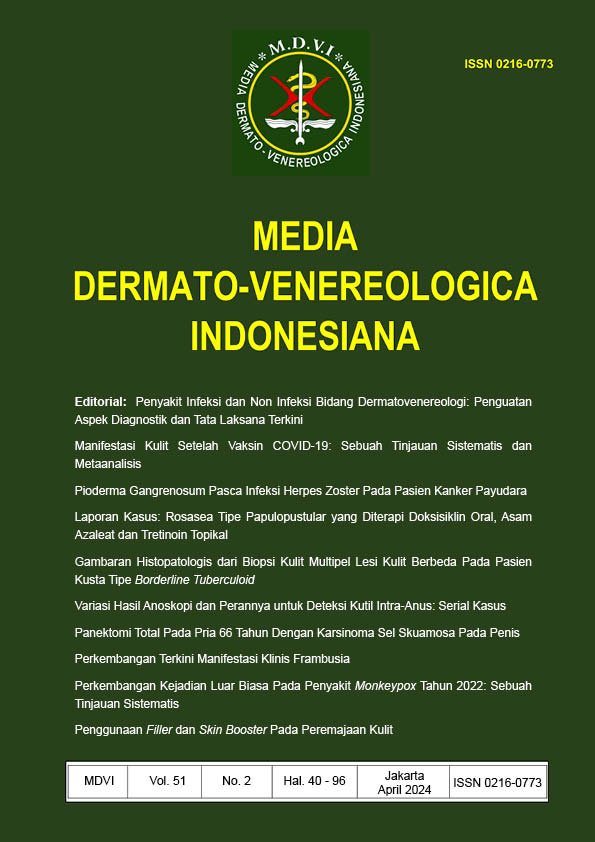TOTAL PANECTOMY IN 66 YEARS OLD MAN WITH SQUAMOUS CELL CARCINOMA (SCC) OF THE PENIS
DOI:
https://doi.org/10.33820/mdvi.v51i2.408Keywords:
Kanker Penis, Karsinoma Sel Skuamosa (KSS), PanektomiAbstract
Introduction: Squamous cell carcinoma (SCC) of the penis is a rare malignancy originating from the epithelial cells of the inner prepuce or glans penis. The most common feature is the presence of a visible and palpable lesion on the penis, which is accompanied by pain, discharge, bleeding, or foul odor. Case report: A 66-year-old man came to the skin and genital clinic of Adam Malik Hospital with complaint of a lump in the penis which had been getting bigger since 3 months ago. Since 5 months ago the patient complained of sticky and painful foreskin on the penis. There was no history of trauma or warts. The patient is not circumcised and a heavy smoker. Discussion: Not circumcised are one of the risk factors for an increased incidence of malignancy of the penis. SCC of the penis has a predictable pattern of metastases, with regional lymph nodes appearing first, followed by deep lymph nodes and then distant metastases. The results of the pathology examination showed the presence of cancer cells originating from the squamous epithelium that were still well differentiated. This examination can determine the type of cell, the degree of pathology, involvement of the corpora cavernosa, corpora spongiosum, inguinal lymph nodes to cancer-free determination at the proximal border of the penectomy incision. Conclusion: Penile cancer is a cancer that has many risk factors. Patients who have been diagnosed with penile cancer, the treatment chosen is a total or partial penectomy depending on the area of ​​the affected tissue
Downloads
References
2. Lughezzani G, Catanzaro M, Torelli T, Piva L, Biasoni D, Stagni S, dkk. The relationship between characteristics of inguinal lymph nodes and pelvic lymph node involvement in penile squamous cell carcinoma: a single institution experience. J Urol. 2014; 191(4):977-82. doi: 10.1016/j.juro.2013.10.140. [PubMed]
3. Hakenberg OW, Compérat E, Minhas S, Necchi A, Protzel C, Watkin N. EAU Guidelines on Penile Cancer: 2014 Update. European Association of Urology. 2015; p.142-50.
4. Ottenhof SR, Bleeker M, Heideman D, Snijders P, Meijer C, Horenblas S. Epidemiology of Penile Cancer. In: Muneer A, Horenblas S, editors. Textbook of Penile Cancer. Cham: Springer; 2016. p.105-10. doi: 10.1007/978-3-319-33220-8.
5. Marchionne E, Perez C, Hui A, Khachemoune A. Penile squamous cell carcinoma: a review of the literature and case report treated with Mohs micrographic surgery. An Bras Dermatol. 2017; 92(1):95-99. doi: 10.1590/abd1806-4841.20175009. [PubMed].
6. Prayoga DA, Tranggono U. Evaluasi Klinis dan Manajemen Kanker Penis di Rumah Sakit Sardjito, Yogyakarta. Indonesian Journal of Cancer. 2016; 10(1):29-34. doi: 10.33371/ijoc.v10i1.411.
7. Sharma P, Zargar-Shoshtari K, Pettaway CA, Schabath MB, Giuliano AR, Spiess PE. Disparities in penile cancer. Cancer Control. 2016; 23(4):409-14. doi: 10.1177/107327481602300412.
8. Tranggono U, Umbas R. Karakteristik dan Terapi Penderita Keganasan Penis di RS Cipto Mangunkusumo dan RS Kanker Dharmais. Indo J Cancer. 2008; 2:45â€50.
9. Presti JC. Genital Tumors. Dalam: Tanagho EA, McAninch JW, editors. Smith’s General Urology. Edisi keâ€17. New York: The McGraw Hill Companies; 2008. h.383â€6.
10. Hakenberg OW, Comperat EM, Minhas S, Necchi A, Protzel C, Watkin N. EAU Guidelines n Penile Cancer: 2014 Update. Eur Urol. 2015;67(1):142-50
11. Compérat E. Pathology of Penile Cancer. Eur Urol Suppl. 2018; 17(6):132-7. doi: 10.1016/j.eursup.2017.08.005.
12. Hanchanale V, Yeo L, Subedi N, Smith J, Wah T, Harnden P, et al. The accuracy of magnetic resonance imaging (MRI) in predicting the invasion of the tunica albuginea and the urethra during the primary staging of penile cancer. BJU Int 2016; 117(3):439-43. doi: 10.1111/bju.13041. [PubMed]
13. Hakenberg OW, Comperat EM, Minhas S, Necchi A, Protzel C, Watkin N. EAU Guidelines in Penile Cancer: 2014 Update.Eur Urol. 2015;67(1):142â€50

Published
How to Cite
Issue
Section
License
Copyright (c) 2024 Media Dermato Venereologica Indonesiana

This work is licensed under a Creative Commons Attribution-ShareAlike 4.0 International License.













